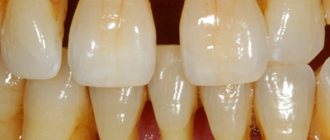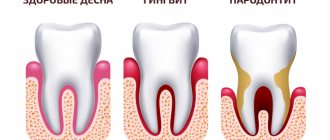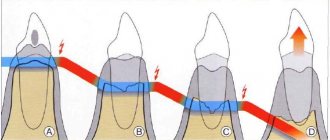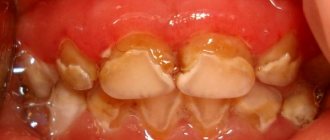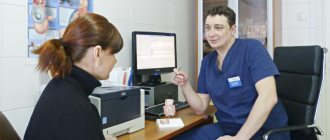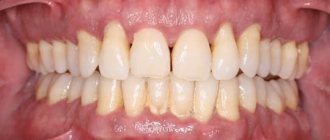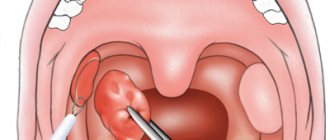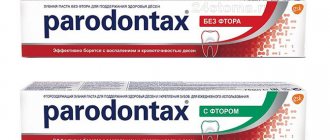Periodontal disease is a term that reflects non-inflammatory systemic damage to the periodontal tissue (periodontal tissue) and this condition is very rare. Periodontium is the tissue that supports the tooth. These include bone, gums, mucous membrane and ligaments connecting these tissues. Periodontitis is an inflammatory process in the tissues surrounding the tooth. Periodontitis is the second most common disease of the dental system after caries.
Periodontitis is an inflammatory disease that causes destruction of the supporting apparatus of the tooth. With periodontitis, the infection enters the space between the tooth and the gum and begins to destroy the ligament of the tooth root with the bone. According to WHO experts, 100% of the adult population of the Earth and 80% of children show some signs of periodontitis. Periodontitis is one of the main causes of tooth loss in older age.
Causes of periodontal disease and periodontitis
The causes of periodontal disease are completely unknown. Hereditary predisposition plays a certain role. Local factors, such as the impact of microorganisms on the periodontium, can only aggravate the process.
Periodontitis can be a consequence of the action of pathogenic microorganisms that accumulate in dental plaque and tartar, tooth trauma, caries, poorly performed dental prosthetics or restoration, and violations of the integrity of the tooth. Significantly increase the likelihood of developing periodontitis, poor oral hygiene, crooked teeth and malocclusion, dietary habits, and a decrease in the general immune reactivity of the patient’s body.
The main cause of gum disease is bacterial plaque.
which is a sticky, colorless film that constantly forms on the teeth. If plaque is not removed, it hardens and forms a rough, porous build-up called tartar. As the disease progresses, toxins can lead to the destruction of the tissues that support teeth. A space is formed between the tooth and the gum - a periodontal pocket, which is filled with plaque. The bone that supports the teeth is subject to constant destruction. Periodontitis can develop after inflammation of gums and gingivitis.
How does periodontal disease occur?
Periodontitis always begins with inflammation of the gums, known as gingivitis. It's not always easy to recognize, but one of the first indicators is bleeding from the gums when brushing your teeth. Your gums may look red and swollen, and you may notice a discolored layer of bacterial plaque on your teeth.
If left untreated, gingivitis can progress to periodontitis, often without any obvious signs. Bleeding from the gums may be less noticeable in smokers due to the effects of nicotine on the blood vessels, and therefore the disease process may be masked.
The rate at which periodontal disease develops depends on the balance of a number of factors:
- the number and type of bacteria on the tooth surface;
- health of the human immune system;
- family history;
- poor oral hygiene;
- smoking, alcohol;
- diabetes, stress, obesity;
- hormonal imbalances.
Sometimes certain medications can provoke the development of the above disease.
Periodontal disease affects a significant number of older people around the world. The mechanisms underlying periodontal disease are relatively well understood, and new research suggests that this health problem may play a role in the development of a number of other conditions, including respiratory disease, Alzheimer's disease, and cancer.
Symptoms characteristic of periodontal disease and periodontitis
Unfortunately, periodontitis tends to develop slowly.
. At the initial stage, periodontitis does not cause pain or other sensations. The disease develops asymptomatically, gradually destroying the periodontium. Therefore, patients, as a rule, are in no hurry to see a doctor. Periodontitis can manifest itself differently depending on the stage, and often begins with bleeding gums. At this stage, the process is still reversible; the periodontal ligament, which surrounds the tooth and connects it with its neighbors, is not affected, so that the chewing pressure is distributed evenly throughout the entire dentition and there is no overload in the periodontal tissues.
Without treatment, the process penetrates deeper
and destroys the periodontal ligament, a periodontal pocket appears, in which, in turn, plaque and stone are deposited and stimulates further progression of the process. Periodontal tissues (surrounding the tooth - gums, bone tissue) are destroyed, and the tooth begins to wobble, losing bone support in the jaw. At this stage, a change in the position of the teeth, their pathological mobility, the appearance of gaps between them, impaired chewing function, and traumatic occlusion may also be observed.
The initial period of the disease is characterized by itching, throbbing in the gums, mobility of teeth, discomfort when chewing, and bad breath. As the process progresses, the supporting apparatus of the tooth becomes looser, tooth mobility increases, the necks of the teeth become exposed and become more sensitive. The lack of adequate treatment measures at this stage leads to the loss of practically healthy teeth.
During an exacerbation, sharp throbbing pain, fever, malaise and weakness occur. There is marked redness and swelling of the gums, and pus is released from the periodontal pocket. Treatment is complex and aimed at stabilizing the pathological process.
Stomatitis and gingivitis in children, symptoms and treatment
The most common inflammatory diseases in children are stomatitis and gingivitis - the first disease is caused by the presence of a fungal infection and is manifested by a characteristic whitish coating on the gums and palate, as well as pain, difficulty swallowing and decreased appetite. Gingivitis in children gives the following symptoms:
- Tingling in teeth and gums.
- Pain while eating.
- Swelling and redness of the mucous membrane.
- Bleeding, unpleasant odor.
A very young or weakened child may also experience enlarged regional lymph nodes, increased temperature, and a general deterioration in health. As a rule, when examining a child’s oral cavity, abundant dental deposits are always revealed, and in some cases, pockets of caries.
When these symptoms appear, it is necessary to show the child to a specialist, since only a doctor can make an accurate diagnosis, differentiate the inflammatory process from a bacterial infection, periodontitis and other diseases with similar symptoms, and also prescribe adequate treatment for gingivitis in children. Therapy should be comprehensive: oral hygiene, antibacterial and anti-inflammatory therapy, nutrition correction. Only in this case will it be possible to successfully cure the disease. Independent attempts to treat bleeding gums will most likely lead to temporary relief and further transition of the process into a chronic form - it is because of self-medication that the process often develops into childhood periodontitis, with more serious consequences for teeth and soft tissues.
If parents notice a fistula or abscess on a child’s gum, treatment must be carried out by a doctor, since we are most likely talking about periodontitis - inflammation at the apex of the tooth root. It is impossible to cope with such a disease at home.
Many children do not like treatment too much, especially from dentists. Therefore, in good clinics they create the most comfortable and inviting conditions for them: a specially decorated office interior, a TV next to the dental chair, etc. The skill of the doctor and his ability to find a common language with young patients also plays an important role. All these conditions are met at the Zuub clinic; competent specialists work here who have extensive experience working with children and know how to win over a child and carry out treatment conveniently, painlessly and effectively.
Treatment of periodontitis
The disease requires urgent intervention by a dentist. Treatment of periodontitis includes non-surgical and surgical methods. The first (professional hygiene) is used in the early stages of the disease and for prevention. They consist of removing tartar (mechanically and ultrasound) and polishing the tooth surface, followed by treating the crown and root of the tooth with special brushes with fluoride-containing protective varnish.
There is a procedure for removing deep tartar called curettage: the doctor removes deposits using special hooks, excavators, curettes (closed curettage), or, if surgery is required, by cutting the gums (open curettage). The goal of surgical methods is to eliminate gum pockets (a consequence of bone tissue resorption) so that the tooth regains stability.
Diagnostics
To determine the presence of periodontal disease and the complexity of its course, you must consult a dentist. The disease is diagnosed by a specialist during a periodontal examination. A dental instrument (probe) is used to carefully measure the groove (pocket or space) between the tooth and gum. A healthy sulcus is three millimeters or less deep and does not bleed. As periodontal disease progresses, the pockets usually deepen.
To establish the correct diagnosis, the dentist examines the mobility of the teeth, the degree of bleeding and inflammation of the gums. After reviewing the patient's medical history, the doctor determines various factors that influenced the development of this disease.
X-ray examination is one of the main stages of diagnosis, since the image will reflect bone loss.
What can a doctor do?
Only the dentist and hygienist with a simple examination
can determine the presence or absence of periodontal disease. The essence of the study is to measure the periodontal pocket (for periodontitis) using a special probe and an x-ray. This method allows the doctor to quickly and painlessly assess the condition of your gums, propose a treatment plan to prevent further development of the disease, and develop a special self-hygiene regimen that will suit your specific situation.
How is the disease treated?
Treatment of the disease in children is not much different from that in adults. It involves professional hygiene and attending various physical procedures. If the problem is a short frenulum, surgery may be required. If there is an incorrect bite, it is corrected step by step.
If necessary, in addition to the pediatric dentist, the patient is examined by a surgeon and an orthodontist. The treatment plan is always drawn up on an individual basis, taking into account the reasons that led to the development of the disease.
It is also very important to exclude the presence of systemic pathologies (for example, diabetes mellitus). If they are detected, their treatment is indicated.
Periodontal disease therapy at Medline-Service
A network of multidisciplinary medical clinics providing a wide range of dental services offers favorable conditions and quite affordable prices for the treatment of periodontal disease. The list of our advantages includes:
- availability of modern diagnostic and treatment equipment;
- use of advanced materials and technologies;
- Extensive practical experience of our doctors, combined with knowledge of the latest achievements in the field of dentistry.
To make an appointment with a periodontist, clarify the current cost of services and other information you are interested in regarding the diagnosis and treatment of periodontal disease, call the phone number listed in the “Clinic Addresses” section.
Is periodontal disease contagious?
Numerous studies suggest that periodontal disease is caused by an inflammatory response to bacteria under the gums, so it may not technically be contagious. However, bacteria that cause the inflammatory response can be spread through saliva. This means that if one of your family members has periodontal disease, it is recommended to avoid contact with saliva by not sharing utensils or oral care items. If you notice that your spouse or family member has warning signs of a possible periodontal problem (bleeding, red and swollen gums, or bad breath), you may want to suggest they visit a periodontist for an evaluation. This can help protect the oral health of everyone in the family.
